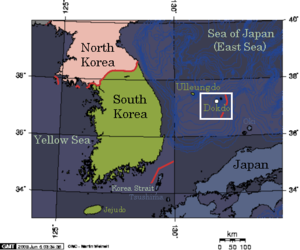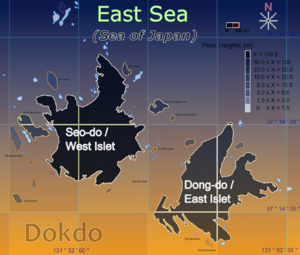Dokdo (Takeshima): Difference between revisions
imported>Chunbum Park No edit summary |
imported>Chunbum Park |
||
| Line 55: | Line 55: | ||
| format = doc | | format = doc | ||
| doi = | | doi = | ||
| accessdate = 2007-09-02 }}</ref> that make up most of the island cluster above water split 2 million years ago,<ref name="cenozoic"/> and are now positioned 151 meters apart from each other.<ref name="net">Korea.net (1999–2006). [http://www.korea.net/News/Issues/issueDetailView.asp?board_no=5727 Dokdo: A Profile]. Retrieved [[9 January]], 2006.</ref> | | accessdate = 2007-09-02 }}</ref> that make up most of the island cluster above water split 2 million years ago,<ref name="cenozoic"/> and are now positioned 151 meters apart from each other.<ref name="net">Korea.net (1999–2006). [http://www.korea.net/News/Issues/issueDetailView.asp?board_no=5727 Dokdo: A Profile]. Retrieved [[9 January]], 2006.</ref> The western islet is steeper and larger than the eastern islet, and it is the tallest islet in the cluster.<ref name="ngii"> | ||
The western islet is | |||
{{cite web | {{cite web | ||
| last = | | last = | ||
| Line 70: | Line 68: | ||
| format = | | format = | ||
| doi = | | doi = | ||
| accessdate = 2007-09-02 }}</ref> The western islet is about 88,640 square meters in area; the eastern islet about 73,300 square meters.<ref name="cyb" /> | | accessdate = 2007-09-02 }}</ref> 78 smaller rocks and reefs scatter around the two main islands within a radius of a few kilometers,<ref name="travel">[http://www.korea.net/News/issues/issueDetailView.asp?board_no=12364 Travel Information], Korea.net</ref> and more than 30 of such geographical features have been named by the South Korean government ministries.<ref name="name">[http://www.dynamickorea.go.kr/news/issues/issueDetailView.asp?board_no=15428&menu_code=A Ten reefs around Dokdo to receive names], Korea.net</ref> | ||
The western islet is about 88,640 square meters in area; the eastern islet about 73,300 square meters.<ref name="cyb" /> | |||
most of the man-made structures are located on the eastern rock.<ref name="corea">[http://www.dokdocorea.com/news-view.htm?p=2&n=5 Dokdocorea.com], date accessed: 2008-05-23</ref> most of the and it is much steeper than | most of the man-made structures are located on the eastern rock.<ref name="corea">[http://www.dokdocorea.com/news-view.htm?p=2&n=5 Dokdocorea.com], date accessed: 2008-05-23</ref> most of the and it is much steeper than | ||
Revision as of 08:49, 24 May 2008
Dokdo is a small group of volcanic rocks located in the Sea of Japan. South Korea administers the islets as an area of the Ulleung County, Northern Gyeongsang Province. The 56-acre (226600 m2) formation consists of two main islands that house a lighthouse, a helicopter pad, and a small police force. Because the rocks shelter various species of birds, plants, and insects, the South Korean government has designated the islets as a nature reserve and enforces measures to protect the islets from the visiting tourists. The sovereignty over Dokdo has been contested by Japan over historical and legal grounds and remains one of the more serious disputes between South Korea and its former colonial ruler. Since at least 1905, the islands were called in Japanese Takeshima (竹島), meaning the "bamboo island". The Korean name has many different transliterations in English, including "Tok-do", "Dok-to", and "Tok Islets" (독도), all of which equate to "rocky island". The islets have two English titles: Liancourt Rocks and Hornet Rocks. "Liancourt" has its origin in the name of the French whaling ship that first encountered and charted the islets in 1849.
Geography
Dokdo lies in the Sea of Japan as a part of an underwater volcano that erupted continuously[2] from 4.6 to 2.5 million years ago.[3] The Dokdo volcano stands 2 km high on its base with a diameter of 20 ~ 25 km and rises to a guyot[4]summit that is 10 km wide.[5] Dokdo is considered the oldest existing island in Korea (Awaji Island is the oldest in Japan)[6]; the second oldest island in Korea is Ulleungdo,[7] which formed 2 million years after Dokdo from the same hotspot.[2] Due to sedimentation, the 2 islands (Seodo and Dongdo in Korean, Nishi-jima and Higashi-jima in Japanese; both literally meaning western island 西島 and eastern island 東島, respectively)[8] that make up most of the island cluster above water split 2 million years ago,[2] and are now positioned 151 meters apart from each other.[9] The western islet is steeper and larger than the eastern islet, and it is the tallest islet in the cluster.[10] 78 smaller rocks and reefs scatter around the two main islands within a radius of a few kilometers,[11] and more than 30 of such geographical features have been named by the South Korean government ministries.[12]
The western islet is about 88,640 square meters in area; the eastern islet about 73,300 square meters.[13]
most of the man-made structures are located on the eastern rock.[14] most of the and it is much steeper than
The islets are 217 km (135 mi) from mainland Korea and 250 km (150 mi) from mainland Japan.[9] The nearest Korean territory (Ulleung-do) is 87 km away (54 mi) and can be visible on fair days (for about 50 days per yearCite error: Invalid <ref> tag; name cannot be a simple integer. Use a descriptive title);[15][9] the nearest Japanese territory (Oki Islands) is 157 km (98 mi) away.[13]
The total area of the islets is about 187,450 square meters (2,017,695 sq ft), with their highest point at 168.5 meters (554 ft) in the western islet.
In 2006, Professor Son Yung-gwan claimed that the islets would sink in 2 million years..[16]
Notes
- ↑ Part I: Profile of Dokdo
- ↑ 2.0 2.1 2.2 Geographical and Geological Features of Dokdo. Truth of Dokdo. Retrieved on 2007-09-03.
- ↑ Volcanic Landforms, The National Atlas of Korea, retreived 2008-05-10
- ↑ A study on the geophysical characteristics of the summit of the Dokdo volcano in the East Sea (Japan Sea)
- ↑ History and Culture of Dokdo Islands, Geographical understanding
- ↑ 2003 iEARN Conference News. '. Retrieved on 2007-09-03.
- ↑ The Territorial Sovereignty over Dokdo Islets(Liancourt Rocks) and the Cairo Declaration in 1943. Seoul National University. Retrieved on 2007-09-03.
- ↑ Special Report: Tokdo-Takeshima Dispute (doc). Pride of Korea - Dokdo (2001-07-06). Retrieved on 2007-09-02.
- ↑ 9.0 9.1 9.2 Korea.net (1999–2006). Dokdo: A Profile. Retrieved 9 January, 2006.
- ↑ Dokdo of Korea. National Geographic Information Institute. Retrieved on 2007-09-02.
- ↑ Travel Information, Korea.net
- ↑ Ten reefs around Dokdo to receive names, Korea.net
- ↑ 13.0 13.1 Cite error: Invalid
<ref>tag; no text was provided for refs namedcyb - ↑ Dokdocorea.com, date accessed: 2008-05-23
- ↑ DKB News. UL1.jpg. Retrieved 9 January, 2006.
- ↑ "독도, 일본보다 빠른 속도로 침몰하고 있다", The Korea Times, 2006/12/01. 손영관교수 `독도ㆍ울릉도 `침몰하고 있다``, JoongAng Ilbo, 2006/12/01.

